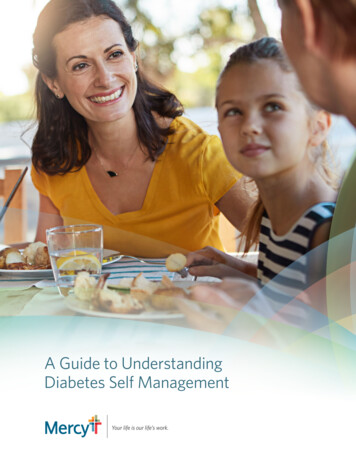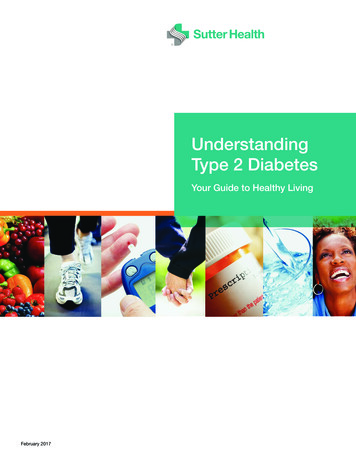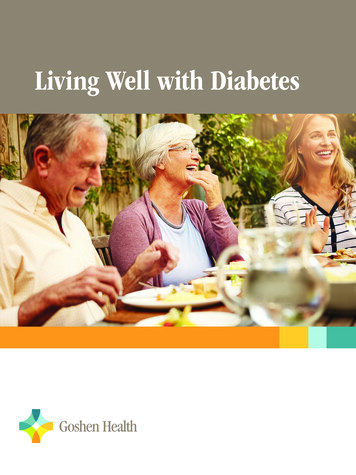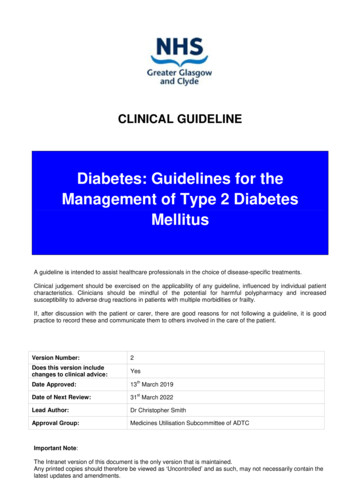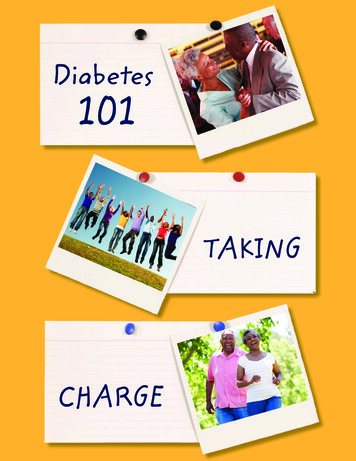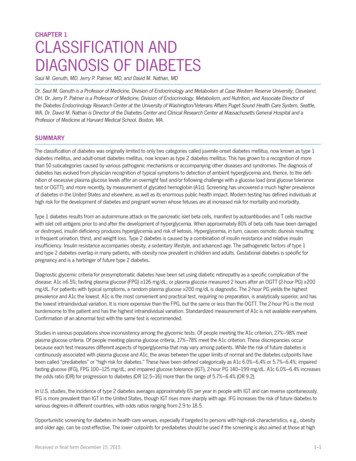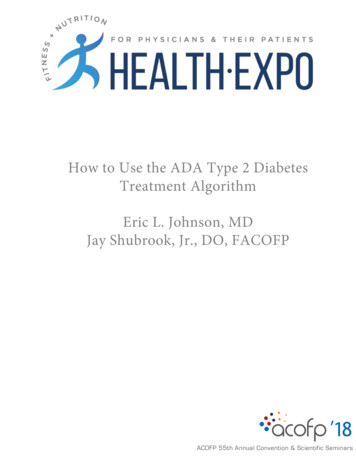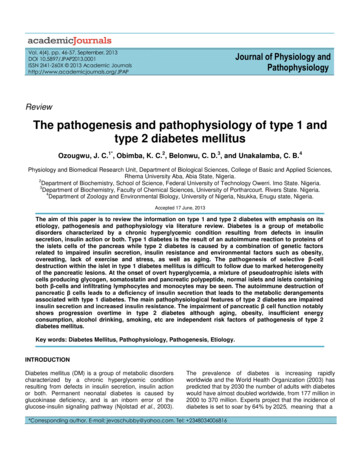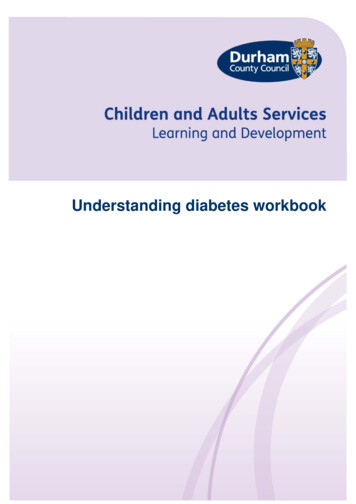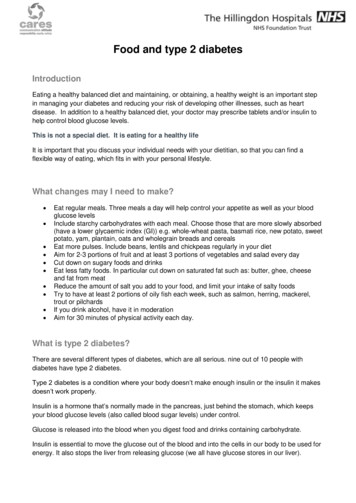
Transcription
Food and type 2 diabetesIntroductionEating a healthy balanced diet and maintaining, or obtaining, a healthy weight is an important stepin managing your diabetes and reducing your risk of developing other illnesses, such as heartdisease. In addition to a healthy balanced diet, your doctor may prescribe tablets and/or insulin tohelp control blood glucose levels.This is not a special diet. It is eating for a healthy lifeIt is important that you discuss your individual needs with your dietitian, so that you can find aflexible way of eating, which fits in with your personal lifestyle.What changes may I need to make? Eat regular meals. Three meals a day will help control your appetite as well as your bloodglucose levelsInclude starchy carbohydrates with each meal. Choose those that are more slowly absorbed(have a lower glycaemic index (GI)) e.g. whole-wheat pasta, basmati rice, new potato, sweetpotato, yam, plantain, oats and wholegrain breads and cerealsEat more pulses. Include beans, lentils and chickpeas regularly in your dietAim for 2-3 portions of fruit and at least 3 portions of vegetables and salad every dayCut down on sugary foods and drinksEat less fatty foods. In particular cut down on saturated fat such as: butter, ghee, cheeseand fat from meatReduce the amount of salt you add to your food, and limit your intake of salty foodsTry to have at least 2 portions of oily fish each week, such as salmon, herring, mackerel,trout or pilchardsIf you drink alcohol, have it in moderationAim for 30 minutes of physical activity each day.What is type 2 diabetes?There are several different types of diabetes, which are all serious. nine out of 10 people withdiabetes have type 2 diabetes.Type 2 diabetes is a condition where your body doesn’t make enough insulin or the insulin it makesdoesn’t work properly.Insulin is a hormone that’s normally made in the pancreas, just behind the stomach, which keepsyour blood glucose levels (also called blood sugar levels) under control.Glucose is released into the blood when you digest food and drinks containing carbohydrate.Insulin is essential to move the glucose out of the blood and into the cells in our body to be used forenergy. It also stops the liver from releasing glucose (we all have glucose stores in our liver).
If your body can’t use insulin properly or produce enough, it can’t use glucose to give you energy.Glucose can then build up in the blood – high blood sugar levels – which can lead to serious healthproblems if not treated.What causes type 2 diabetes?Type 2 diabetes is caused by a combination of lifestyle and genes. Although we don’t know exactlywhy it develops, certain factors do increase your risk, including: Age – being over 40 (or over 25 if you’re South Asian)Weight – being overweight, especially if you have a large tummyEthnicity – being Black African, African Caribbean, South Asian or ChineseFamily link – having a parent, brother or sister with diabetesPrevious medical history – having high blood pressure, a history of heart attacks and stroke,gestational diabetes or severe mental illness treated with anti-psychotic medication.Sometimes, though, there’s nothing to explain why type 2 diabetes develops. Not everyone who’soverweight has it, while some people who are a healthy weight do have it. Knowing why they’vedeveloped type 2 diabetes helps some people cope better with their diagnosis. Once diabetes isdiagnosed, you can get the correct treatment and support.What are the symptoms of type 2 diabetes?Some people with type 2 diabetes have symptoms of high blood sugar levels, while others don’thave any obvious symptoms. Perhaps you have had some of these symptoms without realising theywere linked to type 2 diabetes: Going to the toilet a lot – your body was trying to get rid of the high levels of glucose bymaking you pass more urineBeing really thirsty, drinking more and not being able to quench your thirst – you werebecoming dehydrated, which causes extreme thirstFeeling more tired than usual – your body had less energy as less glucose was entering itscellsLosing weight without trying to – your body started using its fat and protein stores for energybecause it couldn’t use the glucose from the food and drink you were eating.You may have also noticed genital itching or regular episodes of thrush – high blood sugar levels create ideal conditionsfor yeast to grow cuts and wounds that took a long time to heal blurred vision – high blood sugar levels can cause the lens inside your eye to swell (thisusually goes away after a period of time with normal blood sugar levels).
Being diagnosed and getting the right treatment to lower your blood sugar levels to within thenormal range will bring these symptoms under control.How can type 2 diabetes be treated?There are two main treatments for type 2 diabetes:1. Healthy eating and being physically active.2. Healthy eating, being physically active and medication, which may include insulin.Your diabetes team will talk to you about how to manage your diabetes. You may only need to makelifestyle changes at first, but over time you may also need to take diabetes medication, which mayinclude insulin injections.What is a healthy, balanced diet?A healthy balanced diet is based on the five food groups shown in the picture above. Choosingdifferent foods from within each group adds variety. Foods and drinks high in fat and/or sugar arenot beneficial for healthy eating and should only be eaten occasionally and in small amounts.
Starchy foodsStarch based carbohydrates are broken down into glucose and absorbed into your blood. Glucose isneeded to provide your body with energy. Try to choose high fibre, wholegrain varieties wheneveryou can as these are digested more slowly.Top tips: Choose mixed grain, granary, rye or pumpernickel breadsUse brown or wholemeal flourServe without adding extra fat, e.g. butter, oil or gheeChoose wholegrain or oat-based cerealsAvoid sugar and honey-coated cereals and muesli. If you need to sweeten cereals, use asweetener or chopped, fresh or dried fruitChoose basmati rice and serve boiled or steamed rather than friedRoast or fried potatoes and chips should be eaten less often, preferably choose thick chipsMash potato without adding any fat such as butter or olive oilChoose sauces which are low in fat to eat with your pasta, e.g. tomato-based saucesRestrict portion sizes of starchy foods to one third of your plate.Fats and oilsAll fats and oils are high in calories, so if you are overweight you should restrict your intake.Reducing your intake of saturated fat (animal fats and coconut oil) and switching to unsaturated fats,such as vegetable, sunflower, rapeseed, olive or nut oils, can help to lower your cholesterol levelsand reduce your risk of heart disease.Top tips: Use small measured amounts, e.g. instead of pouring use a teaspoon and aim for amaximum 1 teaspoon oil per person per mealChoose monounsaturated oils and spreadsSpread only thinly on bread, toast and crackers, and avoid where ableLower fat varieties may still contain a lot of fat. Use sparingly, and read the labels.Limit your intake of deep fried foods and pastriesThicken sauces with cornflour without adding fatChoose low fat snack foods, e.g. fruit, Ryvita, crackers, oatcakes, rice cakes, breadsticks,cottage cheese, baked crisps, plain popcorn.
Fruit and vegetablesFruit and vegetables are a good source of vitamins, minerals and fibre. Eating at least 2-3portions of fruit spread throughout the day and at least 2-3 portions of vegetables a dayhelps to reduce the risk of heart disease and some cancers. Vegetables are low in calories andcontain very little sugar and therefore can be eaten freely without raising your blood glucose levels.Spread your fruit intake over the day to avoid a sudden rise in blood glucose levels.1 portion is 80g or: 1 medium fruit, e.g. apple, banana, pear, orange2 small fruit, e.g. plum, satsuma, passion fruitA handful of small fruit, e.g. grapes, berries, lychees, tomatoes1-2 slices of larger fruit, e.g. melon, pineapple, mango, papaya2-3 tablespoons of cooked or canned fruit in juice½ - 1 tablespoon of dried fruit, e.g. dates, sultanas, prunes, apricots2-3 tablespoons of vegetables, fresh, frozen or cannedMedium bowl of salad.Pure fruit juices and pure fruit smoothies contain natural sugars and will cause a rise in your bloodglucose, so limit these to no more than 1 small glass per day.Note: Remember that potatoes do not count as a vegetable (see section on starchy foods).Milk and dairy productsMilk, cheese and other dairy products contain calcium, which helps to keep teeth and boneshealthy. Choose 2-3 portions per day. One portion is 200ml of milk, 30g of cheese or a small pot ofyoghurt.Top tips: Replace full fat milk with semi-skimmed or skimmedChoose reduced fat cheese, low fat cream cheese or cottage cheeseChoose strong-flavoured cheese and use lessGrating cheese helps it to go furtherLow fat yoghurts may have a higher sugar content than regular varieties, choose ‘diet’, or fatfree unsweetened yoghurts and compare the label to the chart on the following pages.
Meat, fish and alternativesMeat, poultry, fish, eggs, nuts, pulses and alternative protein sources such as Quorn , soya or tofu,provide us with protein, as well as vitamins and minerals. Pulses are high in fibre, which areparticularly good for helping to control your blood sugar levels. A portion is 80g of lean meat, 140gof fish, 2 eggs, and 4-5 tablespoons of beans or pulses.Top tips: Include 2 portions of these foods each dayChoose lean meat and poultryAvoid fish canned in oil or brine, choose fish in water or a tomato sauce.Avoid adding fat/oil or frying. Instead, choose poached, scrambled or boiled eggs, steamed,grilled or microwaved fish and grilled, stewed or roasted meat/chicken.Beans and pulses such as lentils, kidney beans, butter beans, black eyed peas, chick peas& haricot beans are low in fat, high in fibre and can improve your blood glucose control. Tryadding to stews, casseroles and curries. They can be used alongside, or instead of, meatand chicken.Nuts are quite high in fat so if you are overweight, avoid them as a snack and chooseunsalted varieties.Sugary foods and drinksThese foods and drinks are absorbed by the body and will cause your blood glucose level to riserapidly. Try to reduce your intake of sugary foods and choose low-sugar alternatives. If you follow ahealthy diet, it is not necessary to avoid foods containing sugar completely. Where possible, choosereduced sugar or sugar-free foods and drinks.Top tips: Choose diet, low calorie, or no added sugar, squash and fizzy drinksChoose sugar-free hot chocolate and other milky drinks such as “Highlights ”, “Options ”,or supermarket own brandChoose reduced sugar/no added sugar jams, marmalade and pure fruit spreads and usesparinglyAvoid sugar alternatives such as honey or maple syrupFruit, low fat/sugar yoghurt, sugar-free jelly & low-sugar instant whip are good choices fordessertChoose plain biscuits such as rich tea, oatcakes, wholemeal digestive biscuits.
Artificial sweetenersArtificial sweeteners can be used instead of sugar in foods and drinks. They can be bought astablets or powder, e.g. Canderel, Hermesetas, Natrena, Sweetex, Truvia and Splenda . Thesemay be listed on ingredient labels as Acesulfame-K, Aspartame, Nutrasweet, Saccharin andSucralose. Each brand of sweetener will taste different; it is worth trying different varieties to findwhich ones you prefer.Sweeteners to avoidSome sugar substitutes are a mixture of sugar and sweetener, eg. Half Spoon and Slite . Theycontain some calories and will raise blood glucose.Fruit sugar or fructose, e.g. Fructafin, Fruisana and Sorbitol should be avoided. These contain asmany calories as sugar, are expensive and can cause diarrhoea.What about diabetic foods?Diabetic foods such as sweets, chocolate and biscuits are not necessary. They are often high in fatand calories, expensive and can cause diarrhoea if eaten in large quantities.SaltIt is recommended that the average intake of salt is less than 6g salt (2.4g sodium) approximatelyonly 1 teaspoon per day. This is because larger intakes of sodium increase your risk of heartdisease and stroke. Most people in the UK consume more salt than is recommended.Top tips: Choose less processed foods (ready meals, soups, bottles sauces, canned products)Eat less salty foods (ham, bacon, smoked fish, cheese, salted butter, yeast extracts, stockcubes)Try not to add salt to cooking, instead use herbs, spices, pepper, lemon juice, garlic, vinegaror mustard for flavouring (check food labels of mixed or blended spices)Choose reduced salt varieties where they are availableTry not to add salt to food at the table, and make sure that you always taste food firstCut down on salty snacks such as crisps, salted nuts and biscuits and olivesBuy canned vegetables and fish labelled “no added salt” or those tinned in water not brine oroilCheck food labels to see how much salt per 100g the products you are buying contain. Tryto choose products which fit into the low or medium categories below.Food LabelsWhen reading food labels, always look at the ‘per 100g’ of food column. Try and choose as manyfoods in the ‘low’ category as possible. You should try not to eat too much of foods in the ‘high’
category. The table below shows how high, medium and low levels of fat, saturated fat, sugar andsalt in foods.HighMediumLowFatMore than 17.5g3.1g-17.5g3g or less(Fat) saturatesMore than 5g1.6g-5g1.5g or lessSugarsMore than 22.5g5.1g-22.5g5g or lessSaltMore than 1.5g0.31-g1.5g0.3g or lessSome foods have traffic light labelling on their packaging. The colours on the label show youwhether the amount of fat, sugar or salt in the food is high, medium or low. Try and choose green oramber for healthier option.LOWMEDIUMHealthierchoiceOK mostof thetimeHIGHTry notto eat toomuchWhen checking labels, please note the following ingredients are sugars:Glucose, honey, dextrose, maltose, invert syrup.AlcoholGovernment guidelines for alcohol intake are the same regardless of whether a person has diabetesor not, e.g. no more than 14 units per week for men and women. However, if you are takingcertain medications, or insulin alcohol can cause hypoglycaemia (hypo) for some time afterdrinking.To avoid a hypo whilst drinking alcohol: Drink with meals rather than on an empty stomachDo not miss meals or cut down on your foodAfter evening drinking, have a small starchy snack before you go to bed.One unit is: Half pint of beer, lager or cider – regular strength1 single standard pub measure (25ml) of spirits – e.g. whisky, gin, rum or vodka1 small glass (125ml) wine, sherry or fortified wine.
Remember: Home measures tend to be more generousAll alcohol is high in calories. If you are overweight, try to drink less alcoholCheck that mixers and soft drinks are low calorie, sugar-free or diet varietiesStrong beer and lager contains more alcohol. Home brews can also be much strongerLow alcohol beers and wines can be high in sugar. There is no need to buy special “diabetic”beersAlcopop type drinks are high in both alcohol and sugar and should be avoidedAdd soda water or diet lemonade to wine to make a spritzerAlternate diet or sugar-free drinks with alcohol.Physical ActivityIt is recommended that you should exercise moderately for at least 30 minutes daily. This isbecause of the health benefits that exercise provides, including: Improved blood glucose controlImproving blood pressureImproving levels of fat (eg. types of cholesterol) in the bloodImproving bone health, suppleness and flexibilityImproving mood and general well beingObtaining and maintaining a healthy body weightWhen exercising, your heart rate will raise and you should feel that you are warmer and arebreathing more deeply but not out of breath, you should still be able to hold a conversation.Top tips: Activity can be spread out throughout the day, for example 3 sessions of 10 minutes or 2sessions of 15 minutes.Choose activities that you enjoy: dancing, swimming, bowling, gardening, walking, cycling,kicking a ball around with your children, grandchildren, nieces or nephews.Join a club and exercise and socialise together.Try to walk instead of taking the car, or get off the bus two stops early.Build up gradually and try setting some fitness goals for which you can reward yourself whenyou achieve them.If you are concerned or on medication, discuss any new exercise programme with yourdoctor.
HypoglycaemiaBalancing your blood glucose levels is not always easy and sometimes they may drop too low. Ifthis happens you need to take quick action, so make sure you know what symptoms to look out forand what to do.In people without diabetes the body automatically keeps blood glucose levels within a normal range.If the level starts to drop too low, the body stops producing insulin and releases some of its storedglucose into the blood.When you have diabetes, it is a bit more of a balancing act. It can be difficult to get the right amountof insulin for the food you eat and the activity you do. There will be times when your blood glucoselevels drop too low ( 4mmol/l), and this is called hypoglycaemia, often shortened to “hypo”.What are the symptoms of hypoglycaemia?Everyone has different hypo symptoms but the most common ones include: Feeling hungry Trembling and shakiness Sweating Becoming anxious or irritable Becoming pale Palpitations and fast pulse Tingling sensation on the lips Blurred vision.What are the causes of hypoglycaemia?A hypo is caused by: Having too much insulin for the amount of carbohydrate eaten Medications such as sulphonylureas Missing or delaying a meal Being more active than usual or doing unplanned activity (this can include sex) Drinking alcohol especially on an empty stomach.Sometimes you can have a hypo for no apparent reason.
How do I treat a hypo?It is essential to treat your hypo as soon as you recognise the symptoms, or have tested and foundthat your blood glucose levels are too low. Act quickly, or the hypo may become more severe andyou might become confused, drowsy or even unconscious.Treat your hypo immediately with 15-20g of rapid acting carbohydrate. This can be: 5 dextrose tablets1 mini can of cola (150ml) or half a small glass (100ml) of Lucozade original2 tubes of glucogel (hypostop)1 small glass of pure orange juice (160ml)4 jelly babies.If there is no improvement after 10-15 minutes, repeat the treatment. To stop your blood glucoselevels falling low again you may need to eat some starchy food such as a plain biscuit, a slice oftoast or one banana, especially if it is going to be some time before your next meal. Think aboutwhat has caused your hypo. Hypos should not happen often. If they do, consult your nurse, doctoror dietitian, who might suggest some changes to your treatment.AVOID treating episodes of hypoglycaemia with foods that are high in fat, such as chocolate andbiscuits. Fat will delay the absorption of the glucose and won’t treat the hypo quickly enough.If you are on Insulin Eating regular meals helps to control blood glucose levels. Avoid skipping mealsDiscuss the timing of your insulin and food with your diabetes team, to find a pattern thatsuits youWhen you exercise you may need to lower your insulin dose and/or take extra food. Thisneeds to be discussed with your dietitian or nurseIf you become unwell you still need to take your insulin. If you cannot eat, you may findit easier to drink fluids such as milk, fruit juice, or ordinary Ribena or Lucozade. You willneed to discuss the quantity of these drinks with your diabetic nurse or dietitian.
My Change PlanMaking changes to your diet and lifestyle can be difficult so don’t try to do everything at once. Startwith one or two changes which you feel are achievable. When you are happy with these you couldintroduce some more.The changes I am going to make.How will I do it?Additional information is available from: Diabetes UK http://www.diabetes.org.uk/Change4life http://www.nhs.uk/change4lifeBritish Heart Foundation http://www.bhf.org.uk
Who should I contact if I have a problem or question?Please contact us: Dietetics and Speech Therapy Service, Hillingdon Hospital 01895 279416What should I do in case of an emergency?If your concern is related to your diet please contact us on 01895 279416. If your emergencyis regarding your diabetes please contact your GP or NHS 111.Languages/ Alternative FormatsPlease ask if you require this information in other languages, large print or audio format.Please contact: 01895 279973Fadlan waydii haddii aad warbixintan ku rabto luqad ama hab kale. Fadlan la xidhiidh01895 279 973Jeżeli chcialbyś uzyskać te informacje w innym języku, w dużej czcionce lub w formacieaudio, poproś pracownika oddzialu o kontakt z biurem informacji pacjenta (patientinformation) pod numerem telefonu: 01895 95 279 973 查詢。 يرجى ، باألحرف الكبيرة أو بشكل شريط صوتي ، إذا كنت تود الحصول على هذه المعلومات بلغة أخرى . 01895279973 االتصال بالرقم التالي Ref: PIID 411Date: January 2017Review: January 2019
Food and type 2 diabetes Introduction Eating a healthy balanced diet and maintaining, or obtaining, a healthy weight is an important step in managing your diabetes and reducing your risk of developing other illnesses, such as heart disease. In addition to a healthy balanced diet
